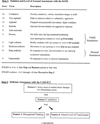Delirium in the cardiovascular ICU: exploring modifiable risk factors
- PMID: 23263581
- PMCID: PMC3557701
- DOI: 10.1097/CCM.0b013e31826ab49b
Delirium in the cardiovascular ICU: exploring modifiable risk factors
Erratum in
- Crit Care Med. 2013 Apr;41(4):e41. Pandhvaripande, Pratik P [corrected to Pandharipande, Pratik P]
Abstract
Objective: Delirium, an acute organ dysfunction, is common among critically ill patients leading to significant morbidity and mortality; its epidemiology in a mixed cardiology and cardiac surgery ICU is not well established. We sought to determine the prevalence and risk factors for delirium among cardiac surgery ICU patients.
Design: Prospective observational study.
Setting: Twenty-seven-bed medical-surgical cardiac surgery ICU.
Patients: Two hundred consecutive patients with an expected cardiac surgery ICU length of stay >24 hrs.
Interventions: None.
Measurements: Baseline demographic data and daily assessments for delirium using the validated and reliable Confusion Assessment Method for the ICU were recorded, and quantitative tracking of delirium risk factors were conducted. Separate analyses studied the role of admission risk factors for occurrence of delirium during the cardiac surgery ICU stay and identified daily occurring risk factors for the development of delirium on a subsequent cardiac surgery ICU day.
Main results: Prevalence of delirium was 26%, similar among cardiology and cardiac surgical patients. Nearly all (92%) exhibited the hypoactive subtype of delirium. Benzodiazepine use at admission was independently predictive of a three-fold increased risk of delirium (odds ratio 3.1 [1, 9.4], p = 0.04) during the cardiac surgery ICU stay. Of the daily occurring risk factors, patients who received benzodiazepines (2.6 [1.2, 5.7], p = 0.02) or had restraints or devices that precluded mobilization (2.9 [1.3, 6.5], p < 0.01) were more likely to have delirium the following day. Hemodynamic status was not associated with delirium.
Conclusions: Delirium occurred in one in four patients in the cardiac surgery ICU and was predominately hypoactive in subtype. Chemical restraints via use of benzodiazepines or the use of physical restraints/restraining devices predisposed patients to a greater risk of delirium, pointing to areas of quality improvement that would be new to the vast majority of cardiac surgery ICUs.
Figures


Comment in
-
Welcome to the fight: the cardiovascular ICU faces the challenge of delirium.Crit Care Med. 2013 Feb;41(2):660-1. doi: 10.1097/CCM.0b013e3182741c00. Crit Care Med. 2013. PMID: 23353945 No abstract available.
-
APOE-based psychopharmacogenetics and delirium.Crit Care Med. 2013 Jun;41(6):e101. doi: 10.1097/CCM.0b013e318287bc0f. Crit Care Med. 2013. PMID: 23685593 No abstract available.
-
The authors reply.Crit Care Med. 2013 Jun;41(6):e101-2. doi: 10.1097/CCM.0b013e31828e8d95. Crit Care Med. 2013. PMID: 23685594 No abstract available.
-
Delirium--a further complication for patients undergoing heart surgery?Crit Care Med. 2013 Sep;41(9):e236-7. doi: 10.1097/CCM.0b013e318291c1ac. Crit Care Med. 2013. PMID: 23979387 No abstract available.
-
The authors reply.Crit Care Med. 2013 Sep;41(9):e237. doi: 10.1097/CCM.0b013e31829641b2. Crit Care Med. 2013. PMID: 23979388 No abstract available.
References
-
- Katz JN, Shah BR, Volz EM, et al. Evolution of the coronary care unit: clinical characteristics and temporal trends in healthcare delivery and outcomes. Crit Care Med. 2010;38:375–381. - PubMed
-
- Rahmanian PB, Adams DH, Castillo JG, et al. Predicting hospital mortality and analysis of long-term survival after major noncardiac complications in cardiac surgery patients. Ann Thorac Surg. 2010;90:1221–1229. - PubMed
-
- Ely EW, Inouye SK, Bernard GR, et al. Delirium in mechanically ventilated patients: validity and reliability of the confusion assessment method for the intensive care unit (CAM-ICU) JAMA. 2001;286:2703–2710. - PubMed
MeSH terms
Substances
Grants and funding
LinkOut - more resources
Full Text Sources
Other Literature Sources
Medical

